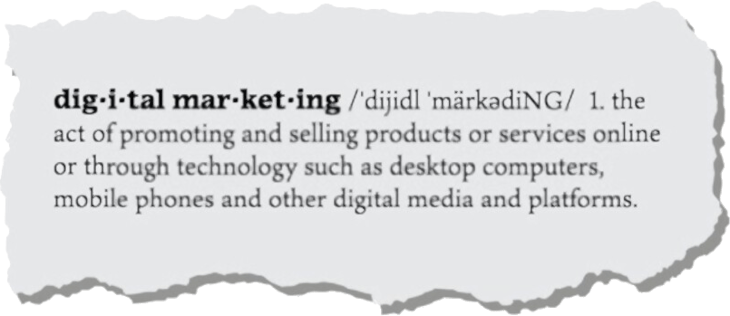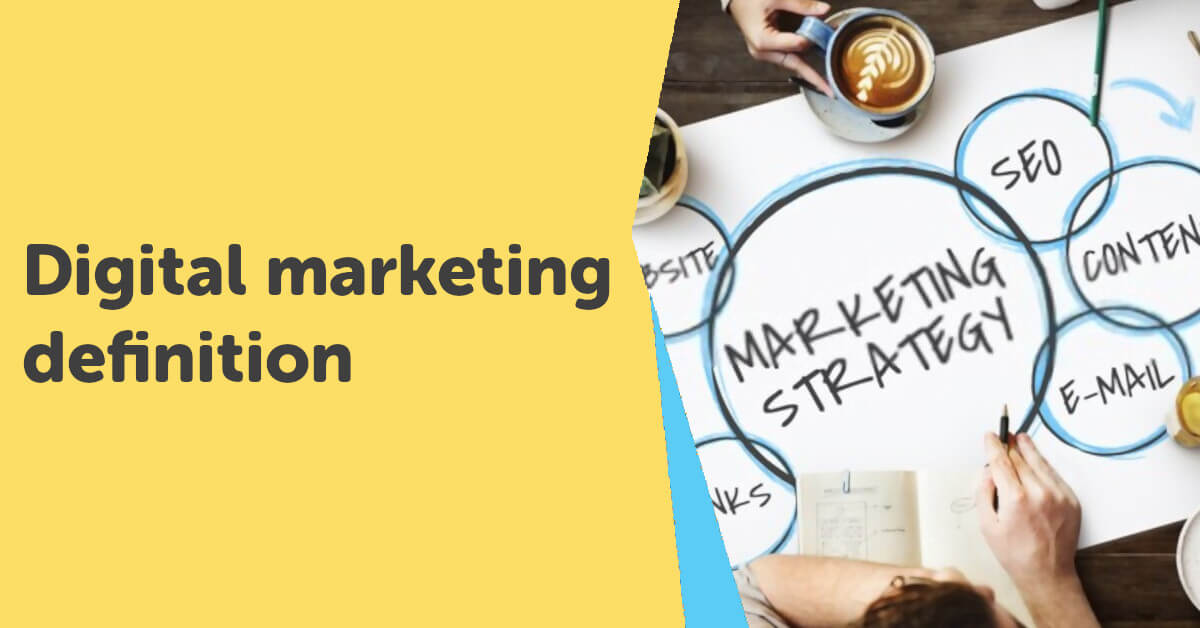Business owners who want online growth to proceed after their online spending often encounter a number of definitions, or terms, that online marketers frequently reference within their parlance. Without a clear understanding of digital marketing definition, these terms may not immediately be clear to business owners and might contribute to some of the confusion in regard to employing online tactics. These terms include, but are not limited to:
- Branding
- Media Buying
- Direct-response marketing
- Inbound Marketing
- Content Marketing
- Buyer’s Journey
My Digital Growth System will get you across these common terms, and the difference between their respective activities. Understanding this is an important skill to have to ensure that your digital resources generate results for your business, as well as your marketing partner’s agency.
My purpose here, however, is to clarify what digital marketing means compared to traditional concepts and activities.

Digital Marketing Definition
Digital marketing, also called online marketing, refers to all marketing efforts that occur on the internet. Businesses leverage digital channels such as search engines, social media, email, and other websites to connect with current and prospective customers. This also includes communication through text or multimedia messages.
Hubspot
Above, Hubspot effectively defines Digital Marketing. In a very broad and generic term, Digital Marketing is simply any form of Marketing that is conducted online.
Essentially, digital marketing is any type of campaign that involves online communications.
Often in business the lines between Advertising, Marketing and Sales on the internet find themselves blurred. Let’s start with a clear definition of each so that we have a solid foundation in order to understand Digital Marketing fully.
Difference between Marketing and Selling
Entrepreneurs and business owners often conflate Marketing and Selling. They often believe Marketing and Selling is the same concept with the same objective.
Selling concepts
Selling concepts are focused on the product. The narrative is on the benefits of a product, it’s relatable to the customer and it influences their decision to buy. This is done by describing the benefits that the product will provide the customer. Sales messaging emphasises the product’s function or capability.

Sales is a short-term strategy based on moving goods
Sales Pros
- Guides the customer. Selling guides consumer behaviour toward adopting and using the product as opposed to considering how the consumer guides the product. Sales work well for unsought goods and can lead to repeat purchases and brand loyalty.
- Product-focused advertising. Selling the features and benefits of a product easily guides advertising efforts. Sales advertising directs customers to the benefits of the product and why the customer should buy the product. Sales concepts guide advertising by creating clear goals for how to sell a product or increase a product’s exposure to potential consumers.
- Stock turnover. Selling is the number 1 short-term strategy when a company has too much inventory. Year-end or seasonal clearance sales are a common practice for many industries.
- Increase market share. Selling concepts will introduce a product to consumers when they are not considering a purchase. They are typically emotive and/or impulsive in nature, and attracting new customers is a key factor in increasing market share via concentrated sales efforts.
Sales Cons
- Short-term focus. The efforts behind a sales campaign are difficult to maintain long term. Selling is a short-term tactic that can soon get on people’s noses if too aggressive, causing them to ignore the messaging or to look elsewhere.
- Ignores customer needs. Sales focus on moving a product and ignore customer needs. Marketing focuses on customer needs, and this strategy leads to growth.
- Risk for poor reviews. Just as the customer’s needs or wants are not considered. Negative feedback is also not considered in the mix. Influencing the buying decision in this manner can increase the potential for negative reviews from one customer to another and online.
Advertising
Before moving on to Marketing concepts, it is prudent to define Advertising. It is important to understand that advertising is akin to selling. Advertising is often lumped in with selling because they are both about the product or service. And with both advertising and selling the messaging is directed to a prospect that already knows what they are looking for. Advertising and selling are all about the features, advantages and benefits. It’s all about the price, the terms, the guarantee, the bonuses.
With advertising and selling the target audience is already product aware. Your communications focus on informing them why your company and product offering is the best option. Advertising and sales are about differentiation.
Advertising Pros
- Extensive reach. Advertising literally puts your brand out there in front of many thousands or even millions of people across the country or globe. This can make you a household name.
- Value proposition. Advertising can be an effective way to quickly establish the value proposition of your product. If you can quickly establish that the perceived value and benefits outweigh the cost, then advertising can instantaneously establish a solid relationship.
- Memorable campaigns. If you can connect and inspire people with a memorable campaign then you’ve achieved the holy grail. We can all relate to a number of memorable advertising campaigns from our childhoods. Nobody can put value on this kind of connection to potential customers.
Advertising Cons
- Untargeted audience. Apart from local advertising, traditional advertising methods, i.e. Television, Newspapers and Billboards are pretty much untargeted. Advertising employs a “scatter-gun approach”: the advertisement is blasted out to the wider marketplace in the hope that the message connects with a small percentage of people that comprises the target consumer base. As an example, a Television advertisement for fishing equipment is broadcast and viewed by the general public, yet this advertisement is only going to be appealing to a small percentage of people that participate in recreational or commercial fishing.
- Higher cost. Advertising has a high cost. Brand Institutional Marketing is more or less the activity of advertising your brand or product under the premise of whoever can pay the most for the advertising space is the winner! So advertising benefits the big Fortune 500 corporations, they are the 20% of the clientele that provides 80% of a media company’s revenue. This is a contributing factor for the ecosystem of alternate mediums and methods small businesses leverage for digital growth.
- Crowded noisy marketplace. The volume of ads we are exposed to keeps growing exponentially. To cope with this information overload we have developed filters. We now tend to block out the things that don’t apply to us. Over time this has reduced the effectiveness of ads. According to Forbes most Americans are exposed to around 4,000 to 10,000 ads each day. For an Australian Baby Boomer, this is the same number of ads that their great-grandparents would have received in their lifetime.
Media Buying
Purchasing and kind of advertising or advertising space from a media company is media buying. This can be both an online media company or offline media company. Online media can be websites, search engines or social media. Offline is the traditional mediums like television, radio print and billboard.
When you buy TV and radio advertising spaces, you are buying media.
Running paid ads on FaceBook, Google and YouTube is media buying.
When you run banner adverts on someone else’s website to communicate to a specific group, you are media buying.
Paying for traffic, from a third-party platform, you’re buying media.
Marketing concepts
Traditional marketing concepts are focused on the customer. Marketing focuses on the idea of satisfying the needs of the customer by means of the product as a solution to the customer’s problem (needs).
The marketing concept utilises marketing data to focus on the needs and wants of customers when developing marketing strategies that not only satisfy the needs of the customer but also accomplish the goals of the organisation.
Marketing is a long-term strategy focused on customer needs, guiding the buyer’s journey. Let’s examine the pros and cons of traditional marketing
Marketing pros
- Local connection. We have a regular diet of local newspapers, television and radio. Almost as you leave your house you encounter billboards on the side of the road and see the sides of council buses wrapped in messaging. Traditional marketing has always connected local communities to businesses and services in their area.
- Builds credibility. Compared to online, the traditional mediums of TV, Radio, Billboard and Print are known to be expensive. Marketing on these mediums implies that the company has substantial financial resources. This provides the perception that the business is stable, growing and thriving.
- Can appeal to a wide audience. Traditional marketing can be a great fit for your brand or business if growth depends on connecting with a wide and diverse group of people.
Marketing cons
- Expensive to make changes. Marketing campaigns provide you with data that is often required to refine future campaigns in order to be more effective. Making changes to the creative and pamphlets, as well as radio or television commercials come at a cost.
- Time and Effort May Not Yield a Return. Marketing requires a fair amount of time from your business. This can become a disadvantage to small businesses that may not have the budget to set up the proper staff to create and run marketing campaigns. As mentioned above marketing often requires some refinement prior to yielding a result.
- Hard to engage a specific audience. Traditional marketing uses a scatter-gun approach where the message is blasted out to the wider marketplace in the hope that the message connects with a small percentage of people that comprises the target audience. It’s not often in traditional marketing where a large percentage of the message recipients are in fact the target audience compared to digital marketing.
Different Types of Marketing
Now that I’ve helped to outline the difference between advertising, marketing and sales in both traditional and online formats. I will make you aware of some of the different types of marketing.
It’s critical that business owners are aware of the different types of marketing.
There are numerous kinds of marketing, in a recent post Asana outlined 19 types of marketing you should know about. That’s quite a number of different types, that may cause a business owner to wonder where to start, or scramble to undertake them all.
Broadly speaking though there are two types of marketing: inbound and outbound. It is essential that you understand these concepts and how they can be applied by corporations like Coca-Cola, Apple and the banks, compared to how they can be applied by small businesses. And what type of marketing you need to do to ensure your marketing resources deliver results.
Outbound marketing is where you reach out to people and start a dialogue before knowing whether or not they have an interest in you, your products or services. You’re inviting prospects to inquire about or buy your product/service without first providing them with a quality experience with your brand.
Inbound marketing involves taking steps to ensure that your prospects may well be interested in working with you by providing them with an experience of your brand, prior to asking them to inquire or buy.
How Businesses Grow from Digital Marketing
The Internet as a medium offers small businesses some unique advantages that were out of reach with traditional marketing. In the early days, the internet leveled the playing field for smaller players that were early adopters.
In addition, a band of “rebel” marketers were notorious for gaining a competitive advantage over big businesses by employing a particular type of inbound marketing on the web. My Digital Growth System helps businesses by clarifying this form of digital marketing with ‘principles’ that can be applied to specific situations as opposed to generic ‘tactics’ that may or may not be best-practice.
Digital marketing pros
- Targeted audience. Even before formulating a marketing strategy, business owners have a very good idea of who their ideal customer is. Digital marketing provides marketers with the opportunity to decide exactly who sees their campaigns based on a wide variety of demographics. This ensures that your advertising spend is putting ads in front of people who are likely to buy your product or service.
- Lower cost. Certain digital channels afford you the opportunity to get in front of your target audience on a regular basis at a minimal cost compared to traditional mediums.
- Personalised content. Offers and messaging can be crafted down to an individual level and in context to previous activity (or inactivity).
- Conversational. The internet facilitates two-way dialogue. As a medium the internet is casual, and it provides businesses with the opportunity to get in on the conversation on a large scale requiring little resources.
- Adaptable to change. Customer opinions and interests change extremely fast nowadays. Digital marketing provides businesses with an opportunity to hone in on what resonates well with their target market, prior to scaling up campaigns.
Digital marketing cons
- Slower uptake. Some digital marketing channels like strategies to earn organic traffic from search engines take months, if not years to take effect, prior to delivering results. This is not for the impatient, or situations requiring fast results.
- Trial and error. Digital marketing is not a ‘one size fits all’ solution. Different markets and products and services require different strategies and tactics. Digital marketing definitely requires experimentation and measurement to uncover what works well for your business. Often these solutions come as a complete surprise to your team.
- Fast-changing environment. The digital marketing landscape changes much quicker than traditional marketing. Opinion, innovation and big media platform policies change quickly and frequently. You can find that an effective strategy quickly becomes obsolete or against FaceBook policy. These situations literally take you back to the drawing board once again to find out what Digital marketing tactics work well for your business.
Digital Marketing Definition: Conclusion
Digital marketing is any type of marketing done on online channels like, websites, email, SMS, search engine, online apps, social media and more.
Business owners are faced with the challenge of finding a cost-effective repeatable process to generate leads and sales. A strong marketing strategy is a critical facet of achieving digital growth.
Creating the right Digital marketing strategies for your business to connect to the right potential clients can be a game-changer in growing your business.


